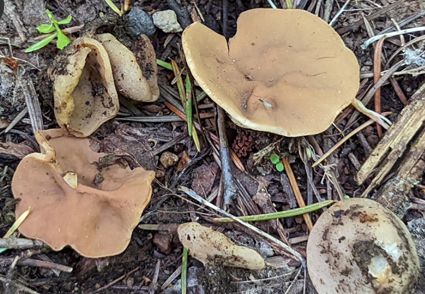Abstract
Gyromitra persicula (Discinaceae, Pezizales), a new species from Washington state, USA, is described. Like its sister species G. leucoxantha, G. persicula has reticulate ascospores with blunt apiculi that form concave depressions resembling a fishtail. Gyromitra persicula is differentiated from G. leucoxantha by its smaller size, peach to buff coloration, and nrDNA ITS. Further collections are required to better understand the distribution and abundance of this discoid Gyromitra, which is currently only known from a small geographic area of temperate rainforest.
References
- Beug, M., Bessette, A.E. & Bessette, A.R. (2014) Ascomycete fungi of North America: A mushroom reference guide. University of Texas Press, Austin, TX, 502 pp.
- Capella-Gutiérrez, S., Silla-Martínez, J.M. & Gabaldón, T. (2009) trimAl: A tool for automated alignment trimming in large-scale phylogenetic analyses. Bioinformatics 25: 1972–1973. https://doi.org/10.1093/bioinformatics/btp348
- Dirks, A.C., Mohamed, O.G., Schultz, P.J., Miller, A.N., Tripathi, A. & James, T.Y. (2023) Not all bad: Gyromitrin has a limited distribution in the false morels as determined by a new ultra high-performance liquid chromatography method. Mycologia 115: 1–15. https://doi.org/10.1080/00275514.2022.2146473
- Edgar, R.C. (2004) MUSCLE: Multiple sequence alignment with high accuracy and high throughput. Nucleic Acids Research 32: 1792–1797. https://doi.org/10.1093/nar/gkh340
- Fries, E. (1849) Summa vegetabilium Scandinaviae. A. Bonnier, 572 pp.
- Gouy, M., Tannier, E., Comte, N. & Parsons, D.P. (2021) Seaview version 5: A multiplatform software for multiple sequence alignment, molecular phylogenetic analyses, and tree reconciliation. In: Katoh, K. (Ed.) Multiple sequence alignment: Methods and protocols. Springer US, New York, NY, pp. 241–260. https://doi.org/10.1007/978-1-0716-1036-7_15
- Guindon, S., Dufayard, J.-F., Lefort, V., Anisimova, M., Hordijk, W. & Gascuel, O. (2010) New algorithms and methods to estimate maximum-likelihood phylogenies: Assessing the performance of PhyML 3.0. Systematic Biology 59: 307–321. https://doi.org/10.1093/sysbio/syq010
- Harmaja, H. (1969) A wider and more natural concept of the genus Gyromitra Fr. Karstenia 2: 9–12. https://doi.org/10.29203/ka.1969.53
- Hoang, D.T., Chernomor, O., von Haeseler, A., Minh, B.Q. & Vinh, L.S. (2018) UFBoot2: Improving the ultrafast bootstrap approximation. Molecular Biology and Evolution 35: 518–522. https://doi.org/10.1093/molbev/msx281
- Imai, S. (1932) Contribution to the knowledge of the classification of Helvellaceae. Shokubutsugaku Zasshi 46: 172–175. https://doi.org/10.15281/jplantres1887.46.172
- Jaczewski, A.L.A. (1913) Opredelitel’ Gribov. Sovershennye Griby (Diploidnye Stadii). I. Fikomitsety. Moscow, 934 pp.
- Kalyaanamoorthy, S., Minh, B.Q., Wong, T.K.F., von Haeseler, A. & Jermiin, L.S. (2017) ModelFinder: Fast model selection for accurate phylogenetic estimates. Nature Methods 14: 587–589. https://doi.org/10.1038/nmeth.4285
- Karakehian, J., Quijada, L., Pfister, D., Tocci, G. & Miller, A. (2021) Methods for observing, culturing, and studying living ascospores. Asian Journal of Mycology 4: 1–18. https://doi.org/10.5943/ajom/4/2/1
- McKnight, K.H. (1968) Artifacts on spores of Discineae induced by common reagents. Mycologia 60: 723–727. https://doi.org/10.2307/3757447
- McKnight, K.H. (1969) A note on Discina. Mycologia 61: 614–630. https://doi.org/10.1080/00275514.1969.12018775
- Miller, A.N., Dirks, A.C., Filippova, N., Popov, E. & Methven, A.S. (2022a) Studies in Gyromitra II: cryptic speciation in the Gyromitra gigas species complex; rediscovery of G. ussuriensis and G. americanigigas sp. nov. Mycological Progress 21: 1–13. https://doi.org/10.1007/s11557-022-01832-x
- Miller, A.N., Karakehian, J. & Raudabaugh, D.B. (2022b) Next-generation sequencing of ancient and recent fungarium specimens. Journal of Fungi 8: 932. https://doi.org/10.3390/jof8090932
- Miller, A.N., Yoon, A., Gulden, G., Stensholt, Ø., Van Vooren, N., Ohenoja, E. & Methven, A.S. (2020) Studies in Gyromitra I: the Gyromitra gigas species complex. Mycological Progress 19: 1459–1473. https://doi.org/10.1007/s11557-020-01639-8
- Nguyen, L.-T., Schmidt, H.A., von Haeseler, A. & Minh, B.Q. (2015) IQ-TREE: A fast and effective stochastic algorithm for estimating maximum-likelihood phylogenies. Molecular Biology and Evolution 32: 268–274. https://doi.org/10.1093/molbev/msu300
- O’Donnell, K., Cigelnik, E., Weber, N.S. & Trappe, J.M. (1997) Phylogenetic relationships among ascomycetous truffles and the true and false morels inferred from 18S and 28S ribosomal DNA sequence analysis. Mycologia 89: 48–65. https://doi.org/10.1080/00275514.1997.12026754
- Pfister, D.H. (1980) On “Peziza” melaleucoides—A species of Gyromitra from the Western United States. Mycologia 72: 614–619.
- Wang, X.-C., Yang, Z.-L., Chen, S.-L., Bau, T., Li, T.-H., Li, L., Fan, L. & Zhuang, W.-Y. (2023) Phylogeny and taxonomic revision of the family Discinaceae (Pezizales, Ascomycota). Microbiology Spectrum 11: e00207-23. https://doi.org/10.1128/spectrum.00207-23
- Wang, X.-C. & Zhuang, W.-Y. (2019) A three-locus phylogeny of Gyromitra (Discinaceae, Pezizales) and discovery of two cryptic species. Mycologia 111: 69–77. https://doi.org/10.1080/00275514.2018.1515456


